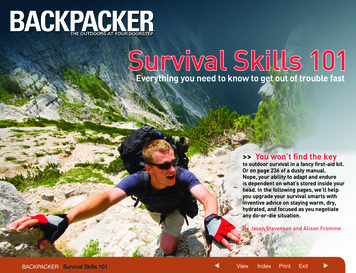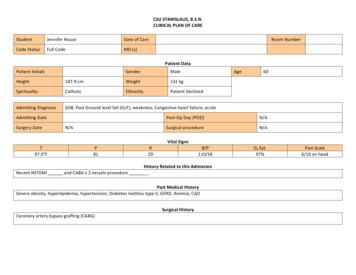
Transcription
Survival Skills 101Everything you need to know to get out of trouble fast You won’t find the keyto outdoor survival in a fancy first-aid kit.Or on page 236 of a dusty manual.Nope, your ability to adapt and endureis dependent on what’s stored inside yourhead. In the following pages, we’ll helpyou upgrade your survival smarts withinventive advice on staying warm, dry,hydrated, and focused as you negotiateany do-or-die situation.By Jason Stevenson and Alison FrommeBACKPACKER : Survival Skills 101ViewIndexPrintExit
2CONTENTSThou Shalt Not Panic. 3Lead Us into Salvation. 4Edible Plants. 4How to . 5Quick Clinic. 7Backcountry Shelters . 8Knots to Know . 9Was Lost, Now I’m Found. 10Before You Go: Leave your itinerary with a trusted friend or family member,along with a designated call-in time for your return. Describe your car and where you’ll park. Register at the appropriate park office or trailhead kiosk. Put a note on your dashboard, detailing your route andestimated return time. Bring all necessary maps or photocopy the essential mappages from a book. Pack a signaling device, such as a whistle or mirror. Carry a reliable fire starter, such as a butane lighter orflint striker. Determine an emergency bearing to hike to a road or a town. Do a gear shakedown at the trailhead, if you’re in a group.BACKPACKER : Survival Skills 101ViewIndexPrintExit
3Thou Shalt Not PanicHow to avoid a potentially crippling response to emergenciesYou hear the crunch of snapping bones a second before pain flares up your leg.You look down; a gopher hole has wrecked your ankle, turning a pleasant solohike into a survival epic. Fear surges through your brain, and your bodybegins to shake. What’s going on?Know the symptomsPanic is both a physical and a mental reaction, and it can occurindependent of shock. You’re likely to experience an adrenalinespike, muscle trembling, throat constriction, hyperventilation, lossof fine motor skills, nausea, and/or dizziness. Your mind may reactwith hallucinations, irritability, and a movie reel of worst-casescenarios culminating in your death. These responses can spiralout of control and cloud your judgment.Tame your emotions“Anxiety is fueled by catastrophic thoughts,” says Jonathan Abramowitz,a professor of psychology at the University of North Carolina at ChapelHill. To check the spiral, sit down and breathe deeply. Tackle a right-braintask, like taping your ankle.Apply logicOnce you’ve calmed down, “you need to analyze your situation and thinkrationally,” says Abramowitz. Instead of trying to solve the emergency all at once,focus on one small task at a time. Eat. Drink. Look for shelter. Study your map forescape routes and water sources. Test your ankle. If it doesn’t work, pitch your tent.Collect wood. Build a signal fire. And so on.Promote the positiveDon’t worry about the distance to your car, recommends Gino Ferri, author of The Psychology of Wilderness Survival.Remind yourself of your training, and repeat a helpful phrase such as, “I can do this.” Think about family and friends,and the story you’ll tell about this experience.BACKPACKER : Survival Skills 101ViewIndexPrintExit
4Lead Us into SalvationTaking charge in a crisis is more art than scienceSpeak up “It takes a lot of courage not to get swept along by a group,”says John Graham, mountaineer and author of Outdoor Leadership.Graham almost died when rough water knocked him off his feet during ariver crossing in Denali National Park in Alaska. He now realizes theincident could have been averted if someone had said, “Hey, this riskisn’t worth it.”Edible PlantsPine treeCut and boil needles for tea rich invitamin C; eat the protein-rich brownand-yellow pollen cones in spring.AcornBoil to remove bitter tannins. Thosefrom white oaks (rounded leaves) andpin oaks (pointy leaves) are less tannic.Express empathy When bad things happen, there’s a clear correlationbetween staying calm and surviving, Graham says. If someone in yourgroup freezes on narrow ledge, show concern for your panicked comrade. “Speak softly, make eye contact, explain the situation honestly,and describe the options,” he advises. Your friendmay be embarrassed as well as scared, sodiscourage others from gawking oroffering conflicting advice.CattailEat the cucumber-like cores of youngshoots, or mash the starch-filledrhizomes (horizontal rootstalks).CloverThese sweet-tasting leaves and rootscan be eaten raw or steamed likespinach.Take command “If your groupis falling apart, there’s no timeto take a poll on what to do,”Graham says. The moreimmediate the danger—a lightning storm on a highridge, for example—the lessgroup harmony matters.“Sometimes top-downleadership is needed, but thatdoesn’t mean barking orders.”Instead, lead with quiet but firminstructions and ask for groupinput only when time allows, orafter the crisis passes.BACKPACKER : Survival Skills 101DaisyPick and eat the young green leaves,or boil the dried white flowers for abitter tea.YuccaSlice, peel, and boil the stems; the whitepetals and thumb-sized fruits can beeaten raw during the summer.ViewIndexPrintExit
5How to .Thaw cold feetSwing your leg forcefully back and forth, like a pendulum.Inertia will force the blood to the tips of your toes.Estimate your distance traveledThe average footstep is 30 inches, and a fit person canwalk 3 mph over flat ground. Determining how far you’vewalked is critical for navigating through a whiteout ordense forest—or if you’re trying to pinpoint the exactlocation of a trail junction or landmark.Find north using a clock faceHold an analog watch flat, with thehour hand aimed at the sun. Southwill be halfway between the hourhand and 12. North is 180 degreesin the opposite direction. Adjustfor daylight saving time by using1:00 instead of noon. If you weara digital watch, draw a clock faceon the ground. This technique worksfor North America below Alaska,but it should only be used for emergencynavigation. Always bring a compass anda map of your route.Orient yourself using the moonIf the crescent moon rises before the sun goes down(a first-quarter moon), its illuminated side will facewest. If it rises after midnight (a last-quarter moon),the bright side will face east. (Using the North Star iseasier and more reliable, but try this lunar method ifstars are obscured.)BACKPACKER : Survival Skills 101Find a natural bandageGather dried sphagnum moss—soft, bushy, green clumps—frombogs or swamps. WWI soldiers usedit to stanch their wounds because it’santibacterial and as absorbent ascotton. Press it against a bleeding wound,or bind it on top of a sterile pad afterthe blood clots.Escape biting insectsSeek out windy spots, or apply mud to exposed skin.Rub flakes of birchbark on your skin and clothing—theoil repels bugs. Mosquitoes are attracted to wet anddark-colored clothing, as well as to perspiration. Theyare most active at dawn and dusk, when the air is calm.Identify a coral snakeRemember: “Red on yellow, killa fellow. Red on black, friend ofJack.” Poisonous coral snakes,with adjacent red and yellow bandsand a black head, live predominantlyin the Southeast and Southwest. Similar-looking scarletking snakes, with their adjacent red and black bands,are harmless constrictors that range from Florida toNew Jersey.Rewarm frostbitten skinPlace the white, waxy frozen skin in lukewarm water orapply hot, wet cloths until it becomes pink as blood flowreturns. Never apply dry heat; frostbitten skin burnseasily. To avoid damaging tissue, don’t rub or massageskin. Taking ibuprofen manages pain and can reduce thechance of blood clots.ViewIndexPrintExit
66How to .Self-arrest without an ice axeRoll onto your stomach, facing uphill. Push up with your elbowsto shift more weight to your legs and feet. Your body will create anatural wedge as your boots dig into the ground.Fix a broken shoelaceIf your lace is too short, skip the eyelets near the toes. Just laceup the ankle and cuff of the boot to achieve a tight fit. If you lose anentire shoelace, cut the other one in half.Find north using the stick-and-shadow methodWhen the sun is casting shadows, place a 3-foot stick verticallyinto flat ground. Clear the area around it of debris. Mark thetip of the stick’s shadow with a stone (A). Wait at least15 minutes and mark the end of the shadow again (B).The line connecting the marks roughly coincides with theeast-west line. A line perpendicular to this line throughthe central stick indicates the north-south line.BACKPACKER : Survival Skills 101ViewIndexPrintExit
7How to .Identify and treat heat exhaustionA victim will be sweating heavily, with cool, wet, flushed skin.Dizziness, vomiting, headache, and a rapid pulse are alsopossible. Have the person lie down in a cool, shaded place.Elevate the feet, fan the person, spritz with water, and providecool drinks and salty snacks.Ascend a scree slopeScree slopes often provide obstruction-free access to higherelevations, but they can also be tiring to climb. Kick a step withyour toe into the loose stones and shift your weight onto yourforward foot. Repeat by bringing your back foot up.Descend a scree slopeWalk using short, shuffling steps withyour feet pointed downhill while digging in your heels. In open areaswithout hazards such as cliffs orboulders, try taking longer, plunging steps as if you were descendingpowder snow. An ice axe or trekkingpoles are helpful. Group membersshould move close together or side byside to avoid dislodging rocks that couldinjure someone moving below.Make water from snowMelt snow over a stove by adding a little water to the mixture.Choose the wettest snow you can find. Icicles also work. Nofire? Fill a bottle one-third full with snow or ice and one-thirdwith water. Shake it well and place it between layers of clothing.Do not put the container next to your skin; it will rob your bodyof heat through conduction.BACKPACKER : Survival Skills 101 Quick ClinicEasy treatments for 2 common trail injuriesMinor ankle sprainCause A bad landing or misstep that twists your foot inward,tearing the lateral ligaments.Treatment If your foot can bear some weight, it’s probablya minor sprain or fracture. Swelling can set in quickly, so sitdown and begin RICE (Rest, Ice, Compress, Elevate). Bind theankle with an Ace bandage (or sock) soaked in cool water,while keeping it elevated. After 20 minutes, wrap your ankletightly, or apply tape in a stirrup pattern (down one side,under, up the other side) followed by figure 8’s around theankle. After resting, pop some ibuprofen and try to walk usinga trekking pole. If you feel extreme pain or can’t even limp,you could have a serious sprain or fracture. Stay put, continuewith RICE, and initiate an assisted rescue.Bleeding woundCause Slash from a branch, rock, or errant blade.Treatment Stop the bleeding by applying direct pressure.As bandages become soaked, don’t remove them; place moreon top. Once the bleeding stops, irrigate the cut with highpressure water pumped from a filter or squeezed from aplastic bag. Be sure to remove all flakes of dirt or dried bloodto reduce the chance of infection. Close the wound with abutterfly bandage, or use several quarter-inch strips of ducttape, leaving space between them for fluid to escape. Securea nonsticky dressing over the closure. Apply clean bandageseach day and check periodically for signs of infection such asredness, swelling, pus, or a fever.ViewIndexPrintExit
8How to .Escape an avalancheIf you’re caught in a snowslide, move your arms and legs inswimming motions to remain near the surface and upright. Grabany objects that you can push off against to maintain your balance.As the slide slows down, cup your palms in front of your face tocreate a breathing space before the snow hardens around you.Backcountry Shelters Debris shelterBuild this with pine boughsand forest undergrowth in asheltered spot. Use leaf litteras insulation betweenyou and the ground.Estimate daylightApproximately four fingers of your outstretchedhand between the sun and horizon indicate1 hour of sunlight remaining. Each additionalfinger represents 15 more minutes of daylight. Platform shelterIf the ground is too wet for a debrisshelter, build a platform. Find twolarge trees and lash stout branches between them, 3 to 4 feet off theground. Overhead, hang a tarp orcloth on branches lashed betweenthe trees.Know your water needsIn a temperate climate, a person loses anaverage of 1.5 liters of water every 24hours through sweating, breathing, andurination. Physical exertion and highheat can increase that loss to as muchas 1 liter per hour. The minimum level ofnecessary water replacement dependson the air temperature and your activitylevel. If you’re resting at 80 F, you’ll needto consume a minimum of 1 liter every 24hours to stay alive. If your water suppliesare limited, you need to stay in the shade and avoid exertion.Collect dewWrap absorbent clothing around your lower legs and walk throughtall, dew-covered grasses. Then wring the moisture from theclothing into a container or your mouth.BACKPACKER : Survival Skills 101 Tree pitDig a foxhole in thesnow beneath atree with thick, lowbranches, typically anevergreen. Line it withleaves or pine boughs;the snow will reflectyour body heat.ViewIndexPrintExit
9How to .Splint a broken armWrap a deflated sleeping pad tightlyaround the broken limb; secure the padwith pack straps, and then inflate it. Nopad? Place straight sticks as splints oneither side of the arm and secure themwith straps or cloth strips. Don’t tie knotsdirectly against the skin. Immobilize thelimb by securing it against the victim’sbody. For wrist fractures, rest the forearmon a flat piece of bark and suspendit horizontally with straps from thetorso and neck.Kno
BACKPACKER : Survival Skills 101 View Index Print Exit. 6 Self-arrest without an ice axe Roll onto your stomach, facing uphill. Push up with your elbows to shift more weight to your legs and feet. Your body will create a natural wedge as your boots dig into the ground. Fix a broken shoelace If your lace is too short, skip the eyelets near the toes. Just lace up the ankle and cuff of the boot .











